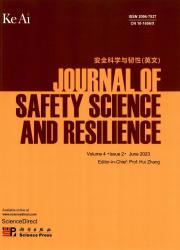住宅外墙堆积物引起的热渗透和热反应
IF 3.4
Q1 PUBLIC, ENVIRONMENTAL & OCCUPATIONAL HEALTH
引用次数: 0
摘要
本文提出了一个广泛的实验调查活动,关于燃烧品牌的热火反应,因为他们积累在住宅的外墙,一个常见的现象在南欧。研究了三种类型的墙体核心层:砖,根据外部保温复合系统(ETICS)方法设计,交叉层压木材(CLT)和普通木材(NW),两者都使用三明治方法。墙体样品由三种砂浆(Tria、Sika和Weber)和各种保温材料(如复合软木、不透水膜、硬质岩棉、防火涂料和挤出聚苯乙烯硬质泡沫塑料(XPS))组合而成,这些材料具有良好的防火和高温性能。然后,在壁面试样的局部表面上沉积火焰,并记录每一层的温度。本研究旨在精确验证火焰对火灾的反应,包括点火类型,烟雾和液滴的产生。还将分析各个保温和墙体系统的保温能力。本文章由计算机程序翻译,如有差异,请以英文原文为准。
Heat penetration and thermal response due to firebrand accumulation on the exterior walls of dwellings
This paper presents an extensive experimental investigation campaign concerning the thermal fire reaction of firebrands, as they accumulate on the exterior walls of dwellings, a common occurrence in southern Europe. Three types of wall core layers were studied: bricks, designed according to the Exterior Thermal Insulation Composite Systems (ETICS) methodology, cross-laminated timber (CLT) and normal wood (NW), both utilizing the sandwich methodology. The wall specimens are made of a combination of materials such as three types of mortar (Tria, Sika, and Weber), and various thermal insulation materials, such as agglomerates of composite cork, impermeable membranes, rigid rock wool, fireproof paint, and extruded polystyrene rigid foam (XPS), which are recommended for their good performance against fire and high temperatures. Firebrands are then deposited on the localized surfaces of the wall specimens, and the temperature is recorded in each layer. This study aims to precisely verify the firebrand reaction to fire, including the type of ignition, smoke and droplet production. The insulation capabilities of each insulation and wall system will also be analyzed.
求助全文
通过发布文献求助,成功后即可免费获取论文全文。
去求助
来源期刊

安全科学与韧性(英文)
Management Science and Operations Research, Safety, Risk, Reliability and Quality, Safety Research
CiteScore
8.70
自引率
0.00%
发文量
0
审稿时长
72 days
 求助内容:
求助内容: 应助结果提醒方式:
应助结果提醒方式:


